Art Review Law Society Sculpture Barna Von Sartory
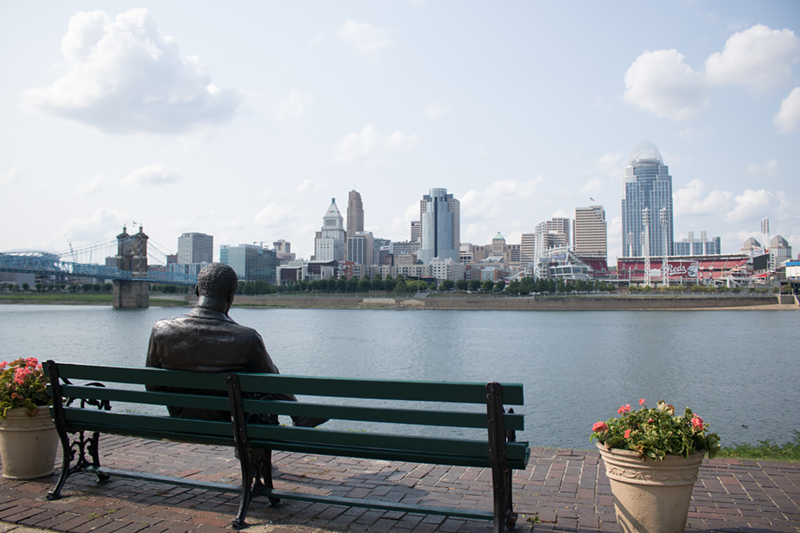
Photograph: Grace Lawler
A statute of abolitionist James Bradly in Covington's Riverside Drive Celebrated District
In the aftermath of Breonna Taylor's killing in Louisville on March 13 and George Floyd'southward in Minneapolis on May 25 — and the murder of countless other unarmed Black citizens before and since — people of all ages, races and ethnicities have come together to protest racial injustice, demanding an end to racist policies and actions today. And they're also calling for the removal of certain public monuments — those which symbolize the inequalities of the past — sometimes defacing and toppling them themselves.
And the protests are not bars to Southern cities where Confederate monuments abound. Fifty-fifty here, north of the Ohio River, people are enervating the removal of particular memorials. Case in indicate, the proposed motility by Cincinnati City Council member Chris Seelbach to remove the William Henry Harrison equestrian statue in Piatt Park. Harrison — the starting time U.Southward. President from Ohio — in one case owned enslaved peoples, participated in the slave trade and politically supported slavery.
Cincinnati's Harrison monument features a bronze-human-on-horse mounted atop a tall granite base. Information technology represents the quintessential definition of "awe-inspiring" — something large, permanent and unchanging. But even if the sculpture's physical appearance has remained the same for decades, its pregnant has changed as society's values take evolved.
By strict definition, a "monument" doesn't need to be large. According to the Oxford English Dictionary, a monument is "a statue, building, or other structure erected to commemorate a famous or notable person or result." So, the piece can be equally modest every bit a metal placard or as grandiose as a neoclassical colonnade. And many incorporate works of art, whether conventional, like an equestrian sculpture, or daring, similar a stainless-steel portal supporting a big rock (more than on that subsequently).
Regardless, a public art monument is just that — public — and it reflects the public'southward many opinions and interpretations, often leading to differences and controversies.
These six art monuments in Cincinnati are all located in and effectually downtown. Some are universally loved; others, not then much. Still over fourth dimension, public opinion has often changed near each one.

Photo: Hailey Bollinger
The Tyler Davidson Fountain — or "Genius of Water" — on Fountain Square downtown
"Tyler Davidson Fountain"
Artist: August von Kreling (Imperial Bavarian Bronze Foundry) // Engagement: 1871 // Location: Fountain Foursquare
The Tyler Davidson Fountain is arguably the metropolis'due south most honey public fine art monument. For nearly 150 years, this urban icon has served equally a gathering place for citywide celebrations. Commissioned by Henry Probasco (who made his fortune selling hardware in the early 1800s), the fountain commemorates Tyler Davidson, Probasco'southward one-time business partner and brother-in-law. And this popular monument is as well dedicated to the people of Cincinnati (every bit evident in the opening credits of WKRP in Cincinnati).
Some say the fountain is also a monument to temperance. In 19th-century beer-drenched Cincinnati, it served as a source of clean water. German language artist August von Kreling designed information technology to be hands accessible, providing an culling to the ever-plentiful ale. The 4 sculptural figures marker the fountain'south perimeter stand for boys with aquatic animals — turtle, snake, duck and dolphin — and water streams from each animal into small basins designed to be (and still performance every bit) drinking fountains.
Typical of high-Victorian eclecticism, the way and detailing are all over the place, incorporating Gothic, Baroque and Classical elements, which often seem to fight one another. However, the creative person modeled the human figures according to Beaux-Arts conventions, each realistically proportioned and naturally posed.
What was controversial at the time — even radical — was Kreling's incorporation of both allegorical and not-allegorical figures within the same piece of work of art. "The Genius of the Water," continuing atop the monument with outstretched arms, is emblematic. From her hands, rain pours downwardly on the figures below who represent everyday people — farmer, bather, healer and firefighter — all benefitting from the many uses of water.
Another bit of controversy: When first installed, the Fountain displaced the city'southward butcher markets, and so located forth Fifth Street. In 1871, the majority of Cincinnati's outdoor public spaces were devoted to commercial utilise; Piatt Park was the only downtown recreational surface area. Merely the city relocated the butchers closer to Findlay market place, and the fountain moved to its new home: a tree-lined "isle" running down the center of 5th Street between Vine and Walnut streets.
In honor of its centennial in 1971, the fountain was relocated to the Fountain Square we know today. But over the by 50 years, more and more structures have cluttered the square and slowly encroached upon the artwork, decreasing the open space around it and making it less of a focal point.
All the same, despite all that, the Tyler Davidson Fountain still remains very accessible — and pop.
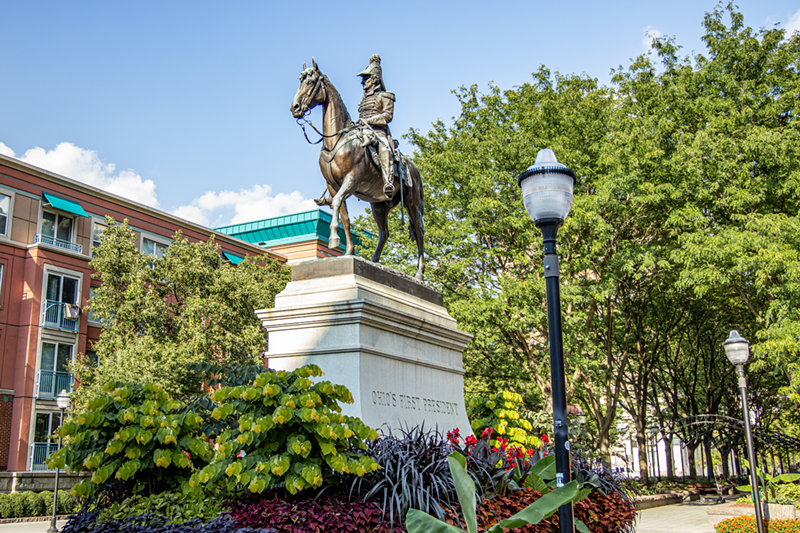
Photo: Hailey Bollinger
A statute of President William Henry Harrison in Piatt Park
"William Henry Harrison"
Artist: Louis T. Rebisso // Date: 1896 // Location: Piatt Park
Cincinnati'southward just bronze equestrian statue is located downtown in Piatt Park. Unveiled in May of 1896, the sculpture represents William Henry Harrison, "Ohio's Get-go President" (and it says so — in huge letters — on the sculpture's base).
The movement to create and install a monument to honour our ninth U.South. President followed a long and circuitous route. X years before its unveiling, in 1886, a "Special Commission on Programme Recommendations" for Cincinnati's centennial celebration of 1888 suggested "the erection of a monument to General William Henry Harrison, first President of the The states from Ohio, to be located in this city."
The timetable proved to exist overly aggressive. A "Memorial Committee" was before long formed and secured $25,000 in funding from the Ohio State Legislature (near $675,000 today). But that was the easy part. In the following years, the process was slowed down by accusations of embezzlement, objections to the choice of creative person (eventually Louis T. Rebisso), delays in approving of the blueprint and the necessary fourth dimension needed to model and cast the sculpture.
Rebisso, a Cincinnati transplant from Italy, studied fine art in his home state, so the sculpture's forms and proportions follow classical models. The bronze horse-and-rider was placed atop a 13-human foot-tall granite pedestal, way up loftier. The monument feels very inaccessible, especially when compared to the Tyler Davidson Fountain, which was unveiled 25 years prior.
A contemporary newspaper account from 1896 reported on the festivities surrounding the unveiling of the Harrison monument "among the blare of trumpets and wild huzzas of the assembled thousands." In his speech communication, Approximate John F. Follett of the monument committee asked the city of Cincinnati to "faithfully and conscientiously protect and preserve this magnificent testimonial to one of our greatest citizens...a perpetual example to our aspiring youth that virtue will ever bring its own reward."
The speeches of 1896 gave no mention of Harrison owning enslaved peoples and supporting the slave merchandise.
Born in Virginia on Berkeley Plantation in 1773, Harrison grew up in a family unit that endemic slaves. In 1791, after his father's death, he joined the U.South. Army and headed w to Fort Washington (located where downtown Cincinnati is today). Harrison made his fashion through the ranks and was eventually appointed first governor of the Indiana Territory in 1800. Effectually that time, he also inherited 11 or 12 enslaved people from his mother (sources differ) and reportedly kept 7 every bit indentured servants at Grouseland, his plantation-like home in Vincennes, Indiana.
Only Harrison was as well personally engaged in the slave trade, purchasing enslaved people from Kentucky on several occasions. Once transported to Vincennes, he changed their legal status from slave to indentured servant (which was little different than slavery itself).
Harrison'due south political support of slavery served to entice white Southerners to relocate to the Indiana territory, helping to force out Native American tribes. He fought confronting the Shawnee and a confederation of American Indians at the Battle of Tippecanoe in 1811, and his victory there helped to evict all Native peoples from the territory, despite a treaty guaranteeing their right to alive on the land.
Later, Harrison moved to North Bend, Ohio, his wife's hometown and became an Ohio politician. He ran for U.S. President, winning the office at historic period 67 in 1840. His only distinction: the shortest term of any President — only 31 days in office. (He contracted pneumonia subsequently giving a ane.five-hour inauguration speech in the pouring rain.)
And so, today's battle rages on. Exercise we keep the Harrison monument in identify, preserving it as a symbol of Ohio's pride of existence "The Mother of Presidents"? Or remove it from its identify of public prominence, to make a argument against the entrenched racism that continues to plague our society?
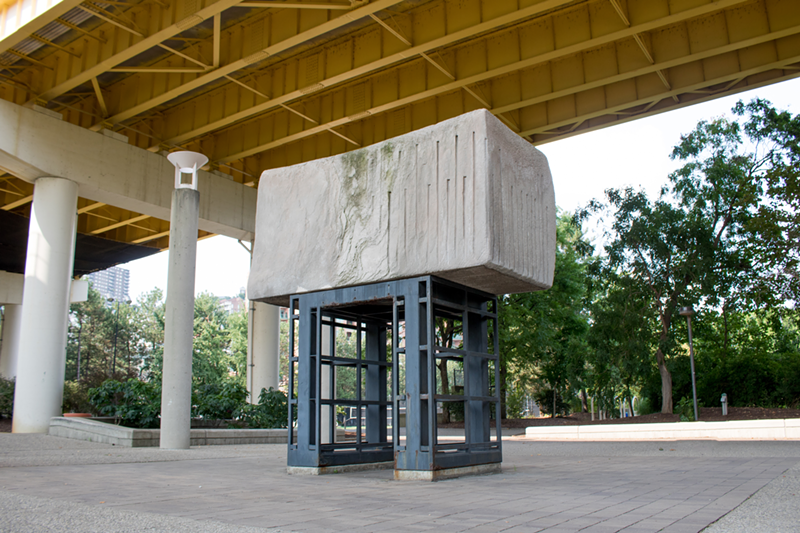
Photograph: Grace Lawler
"Law and Society" at Sawer Point
"Law and Lodge"
Artist: Barna Von Sartory // Date: 1972 // Location: Sawyer Point
In 1972, one year after the Tyler Davidson Fountain was re-dedicated on its centenary celebration, an unconventional — and very controversial — monument appeared on Fountain Square. It soon became the sculpture that everybody loves to detest and is at present exiled to a location underneath the Big Mac Bridge.
Titled "Police and Order," this piece of work of public art commemorates the 100th anniversary of the Cincinnati Bar Clan. It was financed through a private gift from Charles Sawyer, a by president of the Bar Association and old Secretary of Commerce under President Harry Truman. A committee of contemporary art lovers (including Joseph Hirshhorn, the namesake of the Smithsonian's Hirshhorn Museum and Sculpture Garden) chose an obscure Hungarian artist named Barna Von Sartory to create the sculpture.
Sartory'southward design is purposefully abstruse; no representations of people or animals, only instead architectural in form. It features a 35-ton, rough-hewn, Indiana limestone block — nicknamed "The Rock" past Cincinnatians — which sits atop a polished stainless-steel portal. Sartory constructed the monument on Fountain Square where the public could see his process.
But nigh were baffled past what they saw. Co-ordinate to gimmicky newspaper accounts, a common question was: "What is it supposed to exist?" Others concluded, "It's a mess," "It's a disgrace," "It's a urinal for the winos." Then-Cincinnati Metropolis Council member Jerry Springer chosen information technology a "giant rip-off," even though the city hadn't paid a dime for the sculpture. Nonetheless Springer's sentiment seemed to resonate with many Cincinnatians who compared "Law and Society" to the fable of the Emperor's New Clothes and cautioned: "Let the buyer beware."
Although abstract, the creative person intended the sculpture to be symbolic. According to Sartory, the behemothic limestone block represents "Guild" and the cogitating portal represents "Police" (upholding society). He conceived the sculpture equally a kind of gateway to Fountain Foursquare, and local art critics suggested diverse architectural precedents for its grade, including prehistoric megaliths (think Stonehenge), Roman triumphal arches and Japanese torii.
Writing in The Cincinnati Enquirer soon afterward the monument was unveiled, art reporter Owen Findsen admitted that "('Law and Order' is) viewed by virtually with astonishment," but and then he poked fun at Cincinnati'southward conservative tastes, adding that "anyone who expected a effigy of George Washington in a toga was doomed to thwarting."
"Law and Club" was meant to be on brandish on Fountain Square for a brusque time. But the sculpture stayed in place for nigh six years before it was relocated to Regime Square, partially obscured by the bus shelters forth Fifth Street. Effectually 1985, "Law and Society" moved again, this time to Sawyer Betoken, the onetime junkyard turned riverside park — with funds donated past the same Charles Sawyer — and installed past the pocket-size amphitheater.
In 1988, with the creation of Bicentennial Commons, "Constabulary and Society" was moved even so again, this time to a rather undistinguished location under the Daniel Carter Bristles Bridge (aka the Big Mac Bridge). Here's where it stands today, with no marker or label telling visitors the name of the artist or the title of the sculpture or the history behind information technology. And its championship and location are missing from all the Bicentennial Commons maps.
Adding insult to injury, the stainless-steel cladding was vandalized and severely damaged. Cincinnati Parks removed the cladding, revealing the steel construction underneath, which has been painted black. But the steel is at present rusting due to its exposure to the elements.
However no love for this unusual monument.
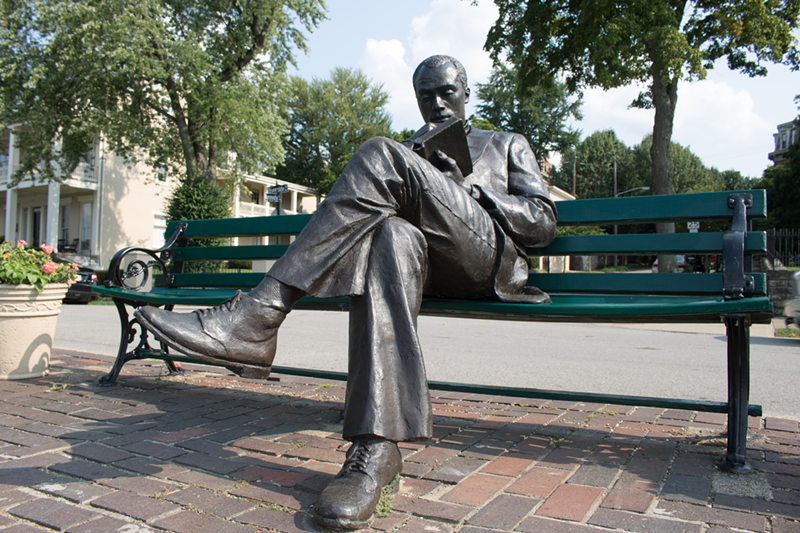
Photo: Grace Lawler
A statue of abolitionist James Bradley in Covington
"James Bradley"
Artist: George Danhires // Date: 1988; restored in 2016 // Location: Riverside Drive, Covington
Trends in fine art come and go — and often, these trends are cyclical. For much of the 20th century, the trend moved away from representation and toward abstraction. But naturalism and realism eventually made a improvement in the 1960s and 1970s.
Around the fourth dimension "Law and Guild" was relocated nether the bridge, a new monument was installed along Covington's Riverside Drive. This installation, sponsored by the Greater Cincinnati Bicentennial Commission, features bronze likenesses of seven historic individuals who stand for a range of personalities with connections to the region spanning fourth dimension, race and gender. From due east to west along the road, these figures are:
- Daniel Carter Beard, founder of the Boy Scouts
- James Audubon, naturalist and artist
- Main Trivial Turtle, military leader
- James Bradley, abolitionist
- Mary B. Greene, steamboat captain
- Simon Kenton, explorer
- John A. Roebling, bridge engineer
Each sculpture was created past a unlike artist — and the quality of each varies. (Sadly, Main Little Turtle's pose is awkward, his proportions are off and he's not well modeled. If this sculpture is intended to be about the idea of the man, rather than his actual likeness, and so it's missed the mark. Chief Little Turtle was a slap-up leader and warrior — zilch about this sculpture conveys that idea.)
However, the best by far is the bronze of James Bradley, a noted abolitionist. The artist, George Danhires, chose to model the figure according to standard human proportions. The Bradley sculpture sports a natural pose as information technology sits on a park bench, facing Cincinnati's skyline, and reads a (bronze) book. It invites interaction with viewers; many sit next to the figure and accept photos, enjoying a spontaneous social media moment.
What we know about James Bradley is largely through Oberlin College. He attended the Lane Theological Seminary in Cincinnati (where Walnut Hills'Thomson-MacConnell Cadillac is located today) as its first African American educatee earlier the "Lane Rebels" relocated to Ohio's Oberlin Higher. Bradley was kidnapped from West Africa at the historic period of 2 and brought to the Usa by slave traders. He was sold to a slave possessor in Pendleton County, Kentucky, but somewhen escaped and made his way to Ohio where he became an important figure in the Underground Railroad. Bradley participated in the Great Lane Seminary Debate of 1834, held at the seminary in Walnut Hills, where he argued in favor of the abolitionism of slavery, only not the return of onetime enslaved peoples back to Africa.
There are no existing portraits of Bradley, so artist Danhires imagined Bradley as a thoughtful, educated human being who fought with the power of his intellect to gratuitous himself and others.
Correct across the river, in Smale Riverfront Park, is another monument to African Americans. These men fought physically for freedom — and for the protection of the whole urban center — during the Civil State of war. Cincinnati'southward Blackness Brigade, a volunteer contingent of 718 men, dug defenses and built fortifications in Northern Kentucky to repel Amalgamated forces. Their story is told by four artists: Tyrone Williams (writer), Eric Brown (graphic designer), John Hebenstreit (sculptor) and Carolyn Manto (sculptor). Completed in 2012, this monument represents a trend in collaboration between artists of diverse backgrounds and talents, bringing more voices together in the conversation.
This is a welcomed modify from the traditional Ceremonious State of war monuments of an earlier era which typically commemorated a single personality, conceived past a single creative person. In the S, the subject area is often a Confederate leader; in the North, it'south ofttimes Abraham Lincoln in the role of the "Great Emancipator."
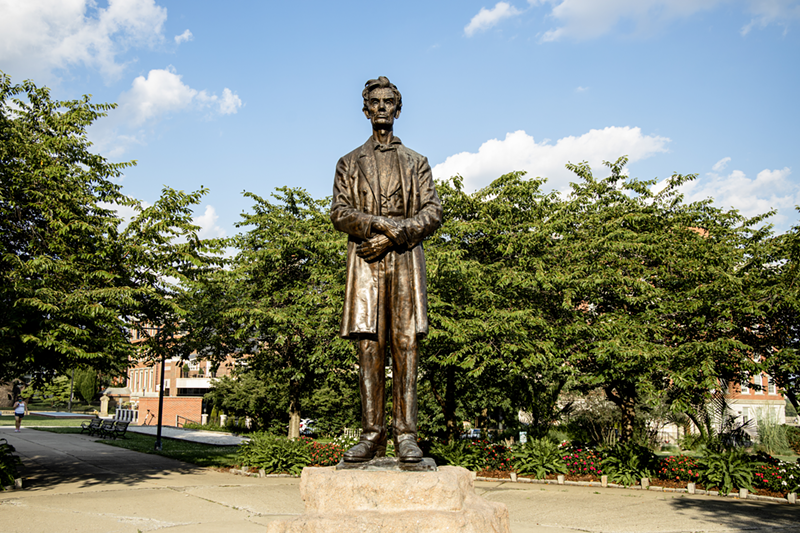
Photograph: Hailey Bollinger
A beardless statute of Abraham Lincoln in Lytle Park
"Abraham Lincoln"
Artist: George Grayness Barnard // Appointment: 1917 // Location: Lytle Park
In 1917, on the centenary of Abraham Lincoln's birth, Charles P. Taft (brother of President William Howard Taft) and his wife Anna Sinton Taft presented a sculpture of Lincoln to Cincinnati.
Today, more than 100 years later, people walk and jog past this statue of Lincoln and retrieve "Oh, it'southward Lincoln," merely when unveiled in 1917, the statuary likeness stirred up a lot of controversy. It was viewed by many — especially art critics — as a caricature of the 16th President of the Us, in contrast to the idealized hero the public was accepted to seeing.
The artist, George Greyness Barnard, modeled his figure of Lincoln with oversized hands and feet and a beardless, wrinkled face, which included a pensive look. Some considered this representation to be disrespectful of the great human being who was credited with preserving the Union and freeing the enslaved.
But looking at the sculpture today, through our contemporary lens, Lincoln's enlarged easily and feet requite the statue a sense of forcefulness. And the pensive qualities of Lincoln'south face convey the huge import of his decisions and responsibilities while in office. (And, reportedly, Lincoln hadn't grown a beard until he ran for President in 1860 at historic period 51 — up to that point, he had a clean-shaven face.)
Currently, the bigger controversy involving a traditional "heroic" likeness of Lincoln revolves around the "Emancipation Memorial" (1876) in Washington, D.C. and its copy in Boston. The monument, created past sculptor Thomas Ball, depicts a Blackness human wearing broken chains kneeling at Lincoln'south feet, apparently in gratitude for his liberty. Protestors have called for the removal of this particular memorial. For now, the original in D.C. is staying in place, only the Boston Art Committee has voted to remove their casting from Boston'southward Park Square. Currently, art conservators in Boston are researching the best way to move it — and Boston officials take non yet determined where the monument will go.
Almost 150 years after the unveiling of D.C.'s "Emancipation Memorial," our telling of history is more than inclusive, and our monuments reflect that. Cincinnati's aforementioned "Black Brigade" conveys the role of African Americans as active participants, not as passive viewers. And the people relaying these stories are more diverse, besides, reflecting the true nature of our society today.
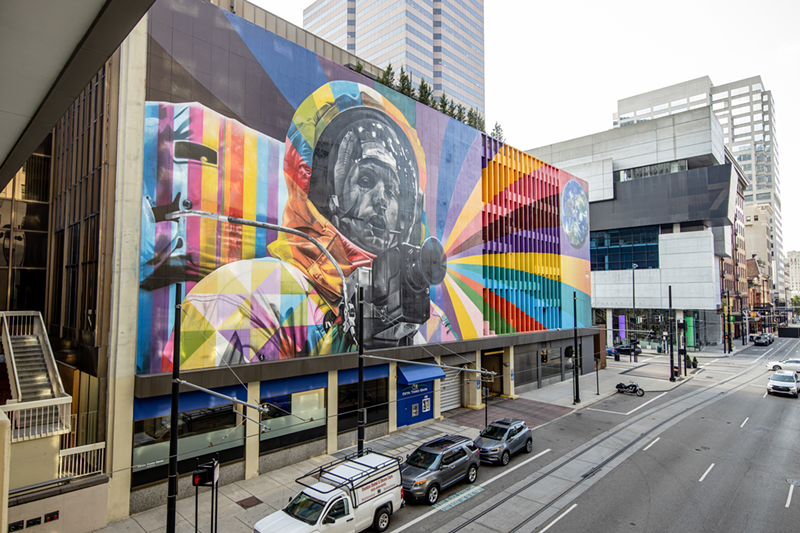
Photograph: Hailey Bollinger
ArtWorks' "Armstrong" landscape downtown
"Armstrong"
Artist: Eduardo Kobra and ArtWorks muralists // Date: 2016 // Location: Sixth and Walnut Streets
Cincinnati's public art of the by 50 years — from the time "Law and Society" was unveiled — counters the notion that monuments are reserved for military generals and national politicians. Today, monuments commemorate a variety of people who manifest the idea of heroism in different ways.
And, these monuments don't need to be sculptural works of art created from bandage metals and carved rock — they can be paintings, also.
For the past 25 years, ArtWorks has produced outdoor murals in and around Cincinnati and Northern Kentucky. Many of these large-calibration works commemorate famous (and not-then-famous) Cincinnatians, including James Brown, Ezzard Charles, the Isley Brothers, Elizabeth Nourse, Annie Oakley, Susan O'Malley, Mamie Smith, Jim Tarbell and even Martha, the terminal Rider Dove.
Past far, the largest ArtWorks mural to-date is located in downtown Cincinnati's arts commune, facing Walnut Street beyond from the Contemporary Arts Middle and the Aronoff Center for the Arts. Truly of awe-inspiring proportions, this piece of work pays tribute to astronaut Neil Armstrong, an Ohio native, and the first person to walk on the moon in 1969, non quite l years earlier the mural was completed in 2016.
Simply titled "Armstrong," this monumental painting was designed by world-famous Brazilian street artist Eduardo Kobra. His mode features photorealistic man figures, typically rendered in black-and-white, and incorporates rainbow colors in a variety of patterns.
Just Kobra didn't create this piece of work on his own. He had help from iv student apprentices. An objective of ArtWorks is to employ local students, ages 14 through 21, to help — and acquire from — professional person artists. To date, ArtWorks has engaged 3,600 students in this artistic process since its founding in 1996.
If only there were some controversy to inject into this work, just with "Armstrong," there isn't much. In fact, most of the murals commissioned through ArtWorks have garnered high praise. "Armstrong" is a great instance of the type of public art being created in Cincinnati today. Its message is clear, and its aesthetics are highly accessible.
The question is: Will the pregnant and relevance of today's gimmicky monuments change in the future? And if so, how? And should we even worry near information technology? It seems that monuments speak more to the people who create them, than to the posterity they are intended to engage.
As for removing those historic monuments which offend today's audiences, quango fellow member Seelbach at present says removal can be a "slippery slope." In a recent phone conversation, he suggests the need for standards to aid decide which monuments to remove and where they should go. To accomplish this, Seelbach is creating a committee of citizens to formulate guidelines, bringing "the public" back into the discussion of public fine art.
*An earlier version of this story incorrectly identified the location of the Lane Seminary debates of 1834, which were held at the Lane Seminary in Cincinnati — downwards the street from the current Harriet Beecher Stowe Firm — not at Oberlin.
Source: https://www.citybeat.com/arts/the-meaning-of-monuments-six-greater-cincinnati-public-art-works-and-how-their-context-has-changed-over-time-12181284
0 Response to "Art Review Law Society Sculpture Barna Von Sartory"
Post a Comment